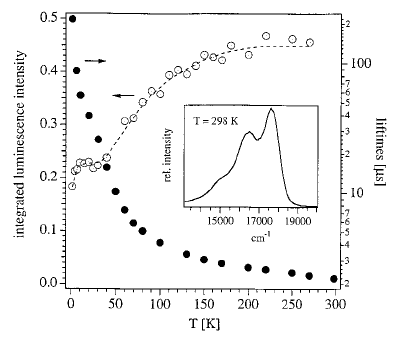-
Luminescence and Energy Transfer of [Ru(bpy)3]2+, [Cr(ox)3]3-, and [Os(bpy)3]2+ in Three-Dimensional Oxalato-Networks
M.E. Von Arx, E. Burattini, A. Hauser, L. Van Pieterson, R. Pellaux and S Decurtins
Journal of Physical Chemistry A, 104 (5) (2000), p883-893


DOI:10.1021/jp993368v | unige:3504 | Abstract | Article HTML | Article PDF

Luminescence and energy transfer in [Zn1-xRux(bpy)3][NaAl1-yCry(ox)3] (x¬†‚Čą 0.01,¬†y¬†= 0.006 ‚ąí 0.22; bpy = 2,2‚Äė-bipyridine, ox = C2O42-) and [Zn1-x-yRuxOsy(bpy)3][NaAl(ox)3] (x¬†‚Čą 0.01,¬†y¬†= 0.012) are presented and discussed. Surprisingly, the luminescence of the isolated luminophores [Ru(bpy)3]2+¬†and [Os(bpy)3]2+¬†in [Zn(bpy)3][NaAl(ox)3] is hardly quenched at room temperature. Steady-state luminescence spectra and decay curves show that energy transfer occurs between [Ru(bpy)3]2+¬†and [Cr(ox)3]3-¬†and between [Ru(bpy)3]2+¬†and [Os(bpy)3]2+¬†in [Zn1-xRux(bpy)3][NaAl1-yCry(ox)3] and [Zn1-x-yRuxOsy(bpy)3] [NaAl(ox)3], respectively. For a quantitative investigation of the energy transfer, a shell type model is developed, using a Monte Carlo procedure and the structural parameters of the systems. A good description of the experimental data is obtained assuming electric dipole‚ąíelectric dipole interaction between donors and acceptors, with a critical distance¬†Rc¬†for [Ru(bpy)3]2+¬†to [Cr(ox)3]3-¬†energy transfer of 15 √Ö and for [Ru(bpy)3]2+¬†to [Os(bpy)3]2+¬†energy transfer of 33 √Ö. These values are in good agreement with those derived using the F√∂rster‚ąíDexter theory.
